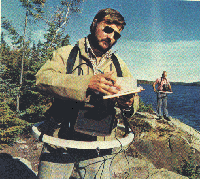Mining in Manitoba
Geophysical Methods
Electromagnetics
 |
|
Of the various electrical methods of prospecting, only the electromagnetic (EM) system can be used in aircraft. Airborne EM systems have been applied with great success, particularly in reconnaissance exploration for massive sulfide ores on the Canadian Shield.
Electromagnetic methods energize the ground inductively by means of an alternating current flowing in a transmitter coil. The resulting signal, containing ground response characteristics, is detected inductively by a receiver coil. Both coils may be mounted in the aircraft, or both placed on the ground. In one recently developed variation of the method, the transmitting coil is on the ground and the receiver in the aircraft.
The method is relatively slow and expensive, particularly when used on the ground in detailed surveys. It has not been widely applied to exploration in the western United States, where ore deposits generally have poor electromagnetic response characteristics and may be deeply and erratically weathered, further destroying the ability of the ore to respond.
There are a variety of inductive electromagnetic (EM) methods that measure subsurface electrical properties. Three common applications of these methods are terrain conductivity measurements, metal detection, and bedrock fracture detection. EM is also used in borehole geophysical logging.
Terrain conductivity surveys are ideal for locating contaminant plumes from salt piles, landfills, and other sources. They can also provide baseline conductivity data around landfill sites prior to construction, and periodically after landfill establishment, to detect and monitor any contaminant plumes. Metal detector surveys can locate buried or hidden metal objects. They can also complement terrain conductivity or GPR surveys by mapping buried waste. Bedrock fracture detection can be accomplished using very low frequency EM (VLF-EM). Locating fractures is often useful in groundwater supply or contamination studies. EM surveys are non-invasive, rapid and economical, making them well-suited for hazardous waste and hydrogeologic studies.
Constraints: Measurements are affected by power lines, metal fences, metal debris, and utilities. Fracture detection is affected by overburden thickness, soil conductivity, and orientation and dip of the fractures.
Method: Electromagnetic induction surveys (terrain conductivity and metal detector) work by inducing current into the ground from a transmitter coil. The resulting secondary electromagnetic field set up by any ground conductors is then measured at a receiver coil. The presence of metals, ions, or clays increases the ground conductivity. Conductivity readings are reported in milliSiemens per meter (equivalent to millimhos per meter). Metal detector readings are generally reported in parts per thousand of the total field.
Detection depth of EM instruments is a function of the transmitter-to-receiver coil separation and the coil orientation (horizontal or vertical). Small coil separations, as in metal detectors and pipe locators, may "see" 2 to 6 feet into the ground. Larger coil separations can be used to detect conductive materials up to several hundred feet deep.
Very low frequency EM (VLF-EM) is an inductive technique which measures very low frequency horizontal EM signals from remote military transmitters. Localized conductors, such as water-filled fractures, cause angular disturbances in this signal which are measured with the VLF-EM instrument (in degrees from the horizontal). VLF-EM can best detect linear, steeply dipping conductors oriented in the direction of the transmitter. Detection depth depends largely upon overall ground conductivity, but is commonly over 100 feet.
Several electromagnetic instruments are used including Geonics EM-31 (with an exploration depth of 18 feet), EM-34 (with a variable exploration depth of 25 to 180 feet), EM-16 (VLF) which is used mainly to locate fractures, and a Fisher M-Scope Metal Detector.